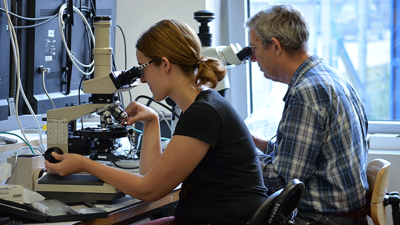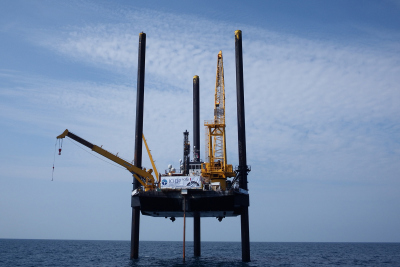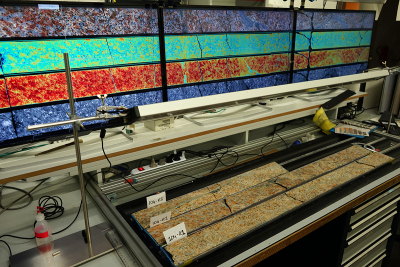Page path:
- Home
- Discover
- Media Releases
- Media Releases 2016
- 11-10-2016 Search for the effects of the Chicxu...
Search for the effects of the Chicxulub asteroid impact on life
In April and May, 2016, a team of international scientists drilled into the site of the asteroid impact, known as the Chicxulub Impact Crater, which occurred 66 million years ago. The crater is buried several hundred meters below the surface in the Yucatán region of México. Until that time, dinosaurs and marine reptiles dominated the world, but the series of catastrophic events that followed the impact caused the extinction of all large animals which led to the rise of mammals and evolution of mankind. This joint expedition, organized by the International Ocean Discovery Program (IODP) and International Continental Scientific Drilling Program (ICDP) recovered a nearly complete set of rock cores from 506 to 1335 meters below the modern day seafloor.
With over 99 per cent successful recovery, these cores will now be studied in detail by the team for a first pass of understanding the effects of the impact on life and as a case study of how impacts affect planets. The cores were first scanned in Texas using medical CT-imaging (Weatherford Labs, Houston, USA) and processed by Enthought, Inc. (Austin, USA). Now they are at the IODP Core Repository at the MARUM – Center for Marine Environmental Sciences, University of Bremen (Germany). There the cores are being split in halves. The 31 person science party and the ECORD Science Operator support team are undertaking a suite of IODP standard measurements on these cores. They take samples for further measurements happening on half of each core with the other half being preserved for future study by the science community and public.
The cores include 120 meters of limestone sediments deposited between 66 million years ago to around 50 million years ago, as well as some 120 meters of broken and melted rocks burying a ring of mountains – the peak ring that surrounds the center of the crater. There is abundant evidence that a vigorous hydrothermal system existed in the wake of the impact with fluids flowing through the broken and melted rocks that cover the peak ring.
While the crater marks the impact – infamous for causing 75 per cent of life on Earth to go extinct –, the team has also found that microbial life found a foothold in the crater likely taking advantage of the chemistry and porous nature of the broken and melted rocks. The team also notes that the sediments that bury the crater, which were recovered in the IODP Expedition 364 cores, include the critical time intervals of when marine life made a recovery at ground zero where ocean conditions may have been toxic for an extended period of time after the impact.
The expedition is conducted by the European Consortium for Ocean Research Drilling (ECORD) as part of the International Ocean Discovery Program (IODP). The expedition is also supported by the International Continental Scientific Drilling Programme (ICDP). The expedition would not have been possible without the support and assistance of the Yucatán Government, Mexican federal government agencies and scientists from the National Autonomous University of Mexico (UNAM) and the Centro de Investigación Científica de Yucatán (CICY).
More information:
About the expedition – www.ecord.org/expedition364
About the research programme – www.iodp.org
About the European part of the programme – www.ecord.org
Contact / interviews / images:
Ulrike Prange
ECORD Science Operator
MARUM – Center for Marine Environmental Sciences
University of Bremen
Email: [Bitte aktivieren Sie Javascript]
Phone: +49 421 218-65540
Carol Cotterill
ECORD Science Operator
British Geological Survey
Email: [Bitte aktivieren Sie Javascript]
Phone: +44 131 650-0315
With over 99 per cent successful recovery, these cores will now be studied in detail by the team for a first pass of understanding the effects of the impact on life and as a case study of how impacts affect planets. The cores were first scanned in Texas using medical CT-imaging (Weatherford Labs, Houston, USA) and processed by Enthought, Inc. (Austin, USA). Now they are at the IODP Core Repository at the MARUM – Center for Marine Environmental Sciences, University of Bremen (Germany). There the cores are being split in halves. The 31 person science party and the ECORD Science Operator support team are undertaking a suite of IODP standard measurements on these cores. They take samples for further measurements happening on half of each core with the other half being preserved for future study by the science community and public.
The cores include 120 meters of limestone sediments deposited between 66 million years ago to around 50 million years ago, as well as some 120 meters of broken and melted rocks burying a ring of mountains – the peak ring that surrounds the center of the crater. There is abundant evidence that a vigorous hydrothermal system existed in the wake of the impact with fluids flowing through the broken and melted rocks that cover the peak ring.
While the crater marks the impact – infamous for causing 75 per cent of life on Earth to go extinct –, the team has also found that microbial life found a foothold in the crater likely taking advantage of the chemistry and porous nature of the broken and melted rocks. The team also notes that the sediments that bury the crater, which were recovered in the IODP Expedition 364 cores, include the critical time intervals of when marine life made a recovery at ground zero where ocean conditions may have been toxic for an extended period of time after the impact.
The expedition is conducted by the European Consortium for Ocean Research Drilling (ECORD) as part of the International Ocean Discovery Program (IODP). The expedition is also supported by the International Continental Scientific Drilling Programme (ICDP). The expedition would not have been possible without the support and assistance of the Yucatán Government, Mexican federal government agencies and scientists from the National Autonomous University of Mexico (UNAM) and the Centro de Investigación Científica de Yucatán (CICY).
More information:
About the expedition – www.ecord.org/expedition364
About the research programme – www.iodp.org
About the European part of the programme – www.ecord.org
Contact / interviews / images:
Ulrike Prange
ECORD Science Operator
MARUM – Center for Marine Environmental Sciences
University of Bremen
Email: [Bitte aktivieren Sie Javascript]
Phone: +49 421 218-65540
Carol Cotterill
ECORD Science Operator
British Geological Survey
Email: [Bitte aktivieren Sie Javascript]
Phone: +44 131 650-0315






